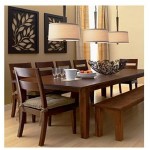Open Kitchen to Dining Room: A Culinary Conversation
The open kitchen design seamlessly blends the culinary and dining experiences, creating a captivating space for food preparation, dining, and entertainment. This architectural concept has gained immense popularity in recent years, transforming homes and restaurants alike into dynamic and inviting environments.
An open kitchen to dining room layout fosters a sense of community and connection. The chef, no longer confined to a separate space, becomes part of the dining experience. Guests can witness the artistry of food preparation firsthand, engaging in conversations about ingredients, techniques, and culinary creations. The removal of walls between the kitchen and dining area promotes a sense of transparency and inclusivity, allowing everyone to participate in the joy of cooking and dining together.
The open kitchen concept also enhances the functionality of the space. By integrating the kitchen and dining areas, the flow of food becomes more efficient, creating a smooth transition from preparation to consumption. Cooks can easily access ingredients and cooking equipment while having direct contact with diners, ensuring prompt and seamless service. This optimized layout reduces foot traffic and minimizes the need for excessive carrying, creating a more efficient and enjoyable dining experience.
In addition to its functional benefits, an open kitchen to dining room design provides ample opportunities for natural lighting. The absence of walls allows sunlight to flood the space, creating a bright and airy atmosphere that enhances the overall ambiance. Natural light has been proven to improve mood, increase productivity, and promote a sense of well-being, making it an essential element in any living environment.
The open kitchen design offers a versatile canvas for personal expression and culinary experimentation. Homeowners can customize their space to reflect their unique style and culinary preferences. Whether it's a sleek, modern kitchen with high-end appliances or a rustic, farmhouse-inspired space with cozy accents, the open kitchen concept allows for endless possibilities. By incorporating personal touches, homeowners can create a space that is both practical and aesthetically pleasing.
When designing an open kitchen to dining room layout, careful consideration should be given to ventilation and odor control. An efficient ventilation system is essential to prevent cooking odors from permeating the dining area. Range hoods, exhaust fans, and open windows can help circulate air and keep the space fresh and inviting. Additionally, the selection of materials for the kitchen area should take into account their resistance to heat, moisture, and stains to ensure longevity and ease of maintenance.
In conclusion, the open kitchen to dining room design offers a plethora of benefits, ranging from enhanced social interaction and functionality to improved natural lighting and personal expression. By seamlessly connecting the culinary and dining experiences, this architectural concept creates a dynamic and inviting space where food, conversation, and entertainment intertwine.

15 Open Concept Kitchens And Living Spaces With Flow Hgtv

Pin Page

The Pros And Cons Of An Open Concept Kitchen Ranney Blair Weidmann

How To Design An Open Kitchen Floor Plan Cliqstudios

Pin Page

Open Kitchen Design For Your Home Designcafe

Open Concept Kitchen Dining And Living Room Palette Pro

How To Open A Kitchen Dining Room Remodelers San Diego

10 Modern Open Kitchen Ideas That Maximize Flow And Function
How To Arrange Furniture In Your Open Plan Kitchen Living Dining Room The House








